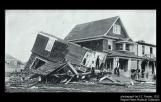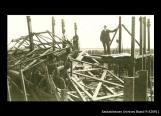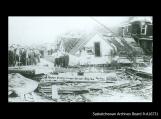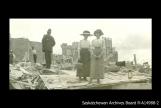5
If one follows the general path of the tornado from south to north, the first structures that were hit were mostly made of wood. They were wood-framed and wood-clad in most cases.Picture winds of hundreds of kilometers an hour hitting structures held together by masses of nails. Nails are an effective way to assemble dwellings when they are not subjected to an excessive amount of vibrations. This is why Inuit wood sleighs or kamotiks pulled over hard-packed snow and ice, over hundreds of kilometers, carrying food and people, are generally assembled today with nylon rope. The rope ensures the structural integrity of the sleigh by allowing vibrations between parts to take place. If there is a structural risk, it is the risk of the rope wearing out. When the rope becomes loose, it is simply tightened.
Nails, on the other hand, allow pieces to be pulled apart. This is why today's modern nails are sometimes coated in resin or spiraled, so they remain in place more effectively. Constant wind would inexorably weaken the bind that keeps clapboard and frames together, until pieces would come apart.
Wood is also a loftier material than brick or stone - not only because it is a less dense and heavy material, but because there is enough surface area to a wood board for any kind of wind to create a lift force. Thus planks have the potential to become the type of elongated missile that achieves great velocity in strong winds.
6
Large areas of debris were left behind by the tornado in residential areas around Regina.1912
Regina, Saskatchewan
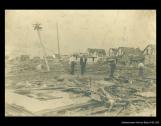
7
It then follows that photographic evidence suggests there were great concentrations of wooden debris after the tornado in the streets and yards of Regina. Our first reaction is to try to imagine just how terribly dangerous it must have been for a human being to be close to weak walls or unsheltered areas at the tornado's passage. Risk of injury was great and independent reports do confirm that there were many.9
The streets of Regina being mostly 66 feet wide - 99 feet for larger arteries - there was ample room for debris to spread over their surface. Larger "chunks", like an attic, a dormer or even perhaps an airborne roof, tended to wedge themselves next to other houses or buildings.10
Wreckage, including out buildings and an automobile behind a house on 14th avenue.1912
14th Avenue, Regina, Saskatchewan
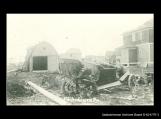
11
In the back lanes, there might have been considerably more clutter, as outhouses, sheds and stables are relatively flimsier structures. It seems there are fewer available photographs with perspectives from back lanes that were either taken or have survived as evidence for us to analyze.12
Debris blocking the space between the Metropolitan Methodist Church and the Y.W.C.A. on Lorne Street1912
Lorne Street, Regina, Saskatchewan
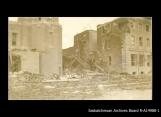
13
This suggests the lanes were less accessible - perhaps muddier as a result of the downpour of rain, but perhaps also because of the damage there as well. Add this to the possibility that some of the livestock kept within city limits at the time might have remained in the outbuildings during the tornado. There likely were many casualties among horses, cows and chickens - the back alleys were not a nice place to go for a post tornado stroll.15
As the tornado moved to downtown, the Canadian Pacific Railway yards and the warehouse district, it encountered more multi-storey buildings made of brick, stone and concrete. There too, debris was strewn across the landscape and rubble remained. Neither brick nor stone buildings were spared. Here is what Frank W. Anderson writes about the destruction of the Telephone Exchange Building. According to him, eight operators were on duty that afternoon, as well as a service man and a janitor:"The tornado wreaked terrible damage on the building, tearing the roof loose and caving in the south wall. The massive switchboard, estimated to weigh some 15 tons, crashed through the floor and into the basement, carrying three operators down with it still in their chairs with their headphones still over their ears. The rest of the girls were trapped in the basement under the collapsed roof and walls, but the three operators who came down with the switchboard managed to work their way out through a basement window with the help of the janitor. They made their way to the nearby Leader newspaper office."
He goes on:
"At first, their story was treated with jocular good humour and they were kidded about 'trying to get their names in the paper', but when the staff realized that the girls were serious they formed a rescue party and hurried to the telephone building. It was only then that they began to realize the enormous force of the storm."
16
E.C. Rossie photograph showing the particular nature of a tornado's pattern of destruction.1912
Regina, Saskatchewan
